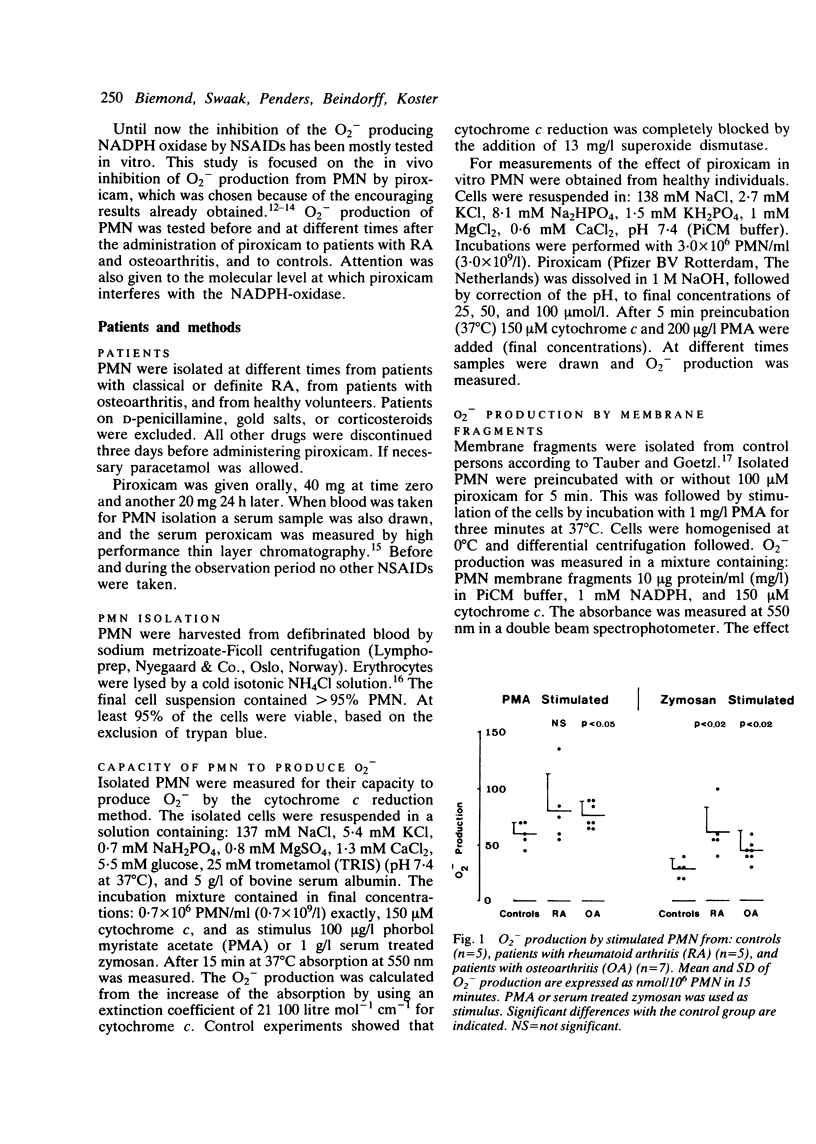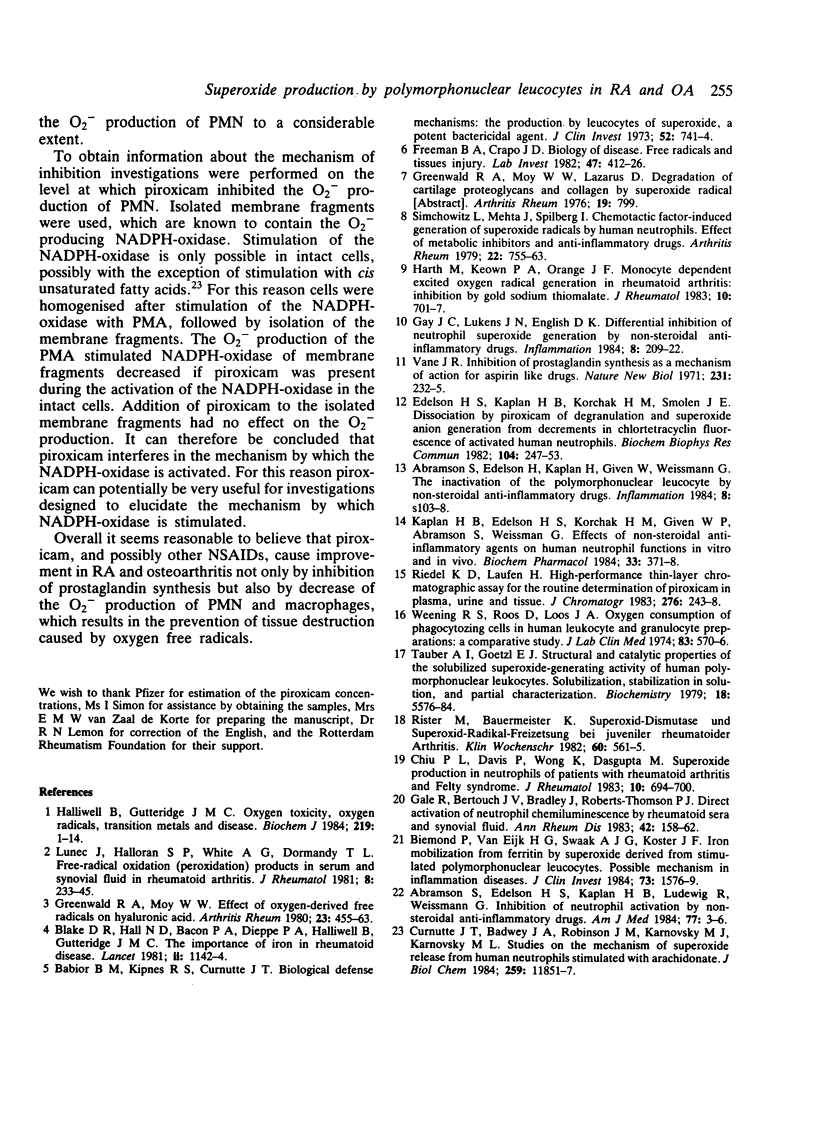Abstract
The superoxide (O2-) production of stimulated polymorphonuclear leucocytes is increased in patients with rheumatoid arthritis and osteoarthritis compared with controls. Treatment of these different groups with pharmacological amounts of the non-steroidal anti-inflammatory drug piroxicam in vivo resulted in a decrease of about 25% in O2- secretion by isolated granulocytes. In vitro experiments showed that piroxicam inhibits O2- production of granulocytes by interference with the stimulation of the NADPH-oxidase. Piroxicam caused diminished O2- production of membrane fragments if it was present during the stimulation of the NADPH-oxidase of the intact cells. During the actual O2- production of the stimulated membrane fragments piroxicam had no effect. It is concluded that piroxicam is able to inhibit granulocyte O2- production by blocking the activation of NADPH-oxidase, which results in diminished tissue destruction by oxygen free radicals in inflammatory diseases.
Full text
PDF






Selected References
These references are in PubMed. This may not be the complete list of references from this article.
- Abramson S., Edelson H., Kaplan H., Given W., Weissmann G. The inactivation of the polymorphonuclear leukocyte by non-steroidal anti-inflammatory drugs. Inflammation. 1984 Jun;8 (Suppl):S103–S108. doi: 10.1007/BF00915717. [DOI] [PubMed] [Google Scholar]
- Abramson S., Edelson H., Kaplan H., Ludewig R., Weissmann G. Inhibition of neutrophil activation by nonsteroidal anti-inflammatory drugs. Am J Med. 1984 Oct 15;77(4B):3–6. doi: 10.1016/s0002-9343(84)80085-6. [DOI] [PubMed] [Google Scholar]
- Babior B. M., Kipnes R. S., Curnutte J. T. Biological defense mechanisms. The production by leukocytes of superoxide, a potential bactericidal agent. J Clin Invest. 1973 Mar;52(3):741–744. doi: 10.1172/JCI107236. [DOI] [PMC free article] [PubMed] [Google Scholar]
- Biemond P., van Eijk H. G., Swaak A. J., Koster J. F. Iron mobilization from ferritin by superoxide derived from stimulated polymorphonuclear leukocytes. Possible mechanism in inflammation diseases. J Clin Invest. 1984 Jun;73(6):1576–1579. doi: 10.1172/JCI111364. [DOI] [PMC free article] [PubMed] [Google Scholar]
- Blake D. R., Hall N. D., Bacon P. A., Dieppe P. A., Halliwell B., Gutteridge J. M. The importance of iron in rheumatoid disease. Lancet. 1981 Nov 21;2(8256):1142–1144. doi: 10.1016/s0140-6736(81)90590-0. [DOI] [PubMed] [Google Scholar]
- Chiu P. L., Davis P., Wong K., Dasgupta M. Superoxide production in neutrophils of patients with rheumatoid arthritis and Felty's syndrome. J Rheumatol. 1983 Oct;10(5):694–700. [PubMed] [Google Scholar]
- Curnutte J. T., Badwey J. A., Robinson J. M., Karnovsky M. J., Karnovsky M. L. Studies on the mechanism of superoxide release from human neutrophils stimulated with arachidonate. J Biol Chem. 1984 Oct 10;259(19):11851–11857. [PubMed] [Google Scholar]
- Edelson H. S., Kaplan H. B., Korchak H. M., Smolen J. E., Weissmann G. Dissociation by piroxicam of degranulation and superoxide anion generation from decrements in chlortetracycline fluorescence of activated human neutrophils. Biochem Biophys Res Commun. 1982 Jan 15;104(1):247–253. doi: 10.1016/0006-291x(82)91966-0. [DOI] [PubMed] [Google Scholar]
- Freeman B. A., Crapo J. D. Biology of disease: free radicals and tissue injury. Lab Invest. 1982 Nov;47(5):412–426. [PubMed] [Google Scholar]
- Gale R., Bertouch J. V., Bradley J., Roberts-Thomson P. J. Direct activation of neutrophil chemiluminescence by rheumatoid sera and synovial fluid. Ann Rheum Dis. 1983 Apr;42(2):158–162. doi: 10.1136/ard.42.2.158. [DOI] [PMC free article] [PubMed] [Google Scholar]
- Gay J. C., Lukens J. N., English D. K. Differential inhibition of neutrophil superoxide generation by nonsteroidal antiinflammatory drugs. Inflammation. 1984 Jun;8(2):209–222. doi: 10.1007/BF00916096. [DOI] [PubMed] [Google Scholar]
- Greenwald R. A., Moy W. W. Effect of oxygen-derived free radicals on hyaluronic acid. Arthritis Rheum. 1980 Apr;23(4):455–463. doi: 10.1002/art.1780230408. [DOI] [PubMed] [Google Scholar]
- Halliwell B., Gutteridge J. M. Oxygen toxicity, oxygen radicals, transition metals and disease. Biochem J. 1984 Apr 1;219(1):1–14. doi: 10.1042/bj2190001. [DOI] [PMC free article] [PubMed] [Google Scholar]
- Harth M., Keown P. A., Orange J. F. Monocyte dependent excited oxygen radical generation in rheumatoid arthritis: inhibition by gold sodium thiomalate. J Rheumatol. 1983 Oct;10(5):701–707. [PubMed] [Google Scholar]
- Kaplan H. B., Edelson H. S., Korchak H. M., Given W. P., Abramson S., Weissmann G. Effects of non-steroidal anti-inflammatory agents on human neutrophil functions in vitro and in vivo. Biochem Pharmacol. 1984 Feb 1;33(3):371–378. doi: 10.1016/0006-2952(84)90228-4. [DOI] [PubMed] [Google Scholar]
- Lunec J., Halloran S. P., White A. G., Dormandy T. L. Free-radical oxidation (peroxidation) products in serum and synovial fluid in rheumatoid arthritis. J Rheumatol. 1981 Mar-Apr;8(2):233–245. [PubMed] [Google Scholar]
- Riedel K. D., Laufen H. High-performance thin-layer chromatographic assay for the routine determination of piroxicam in plasma, urine and tissue. J Chromatogr. 1983 Aug 12;276(1):243–248. doi: 10.1016/s0378-4347(00)85090-2. [DOI] [PubMed] [Google Scholar]
- Rister M., Bauermeister K. Superoxid-Dismutase und Superoxid-Radikal-Freisetzung bei juveniler rheumatoider Arthritis. Klin Wochenschr. 1982 Jun 1;60(11):561–565. doi: 10.1007/BF01724212. [DOI] [PubMed] [Google Scholar]
- Simchowitz L., Mehta J., Spilberg I. Chemotactic factor-induced generation of superoxide radicals by human neutrophils: effect of metabolic inhibitors and antiinflammatory drugs. Arthritis Rheum. 1979 Jul;22(7):755–763. doi: 10.1002/art.1780220711. [DOI] [PubMed] [Google Scholar]
- Tauber A. I., Goetzl E. J. Structural and catalytic properties of the solubilized superoxide-generating activity of human polymorphonuclear leukocytes. Solubilization, stabilization in solution, and partial characterization. Biochemistry. 1979 Dec 11;18(25):5576–5584. doi: 10.1021/bi00592a009. [DOI] [PubMed] [Google Scholar]
- Vane J. R. Inhibition of prostaglandin synthesis as a mechanism of action for aspirin-like drugs. Nat New Biol. 1971 Jun 23;231(25):232–235. doi: 10.1038/newbio231232a0. [DOI] [PubMed] [Google Scholar]
- Weening R. S., Roos D., Loos J. A. Oxygen consumption of phagocytizing cells in human leukocyte and granulocyte preparations: a comparative study. J Lab Clin Med. 1974 Apr;83(4):570–577. [PubMed] [Google Scholar]


